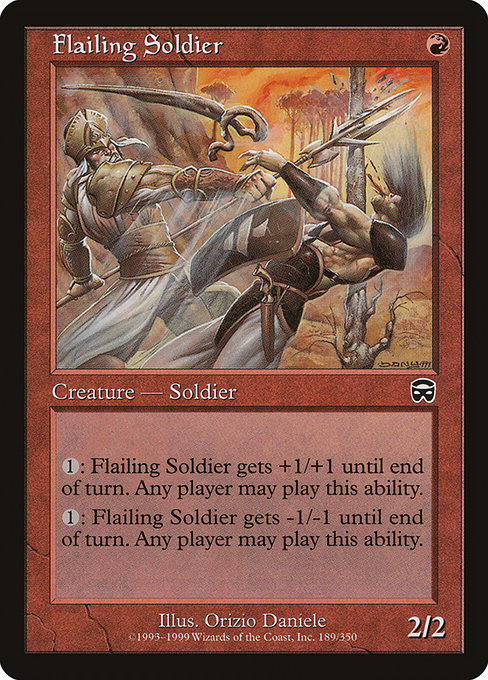
Image courtesy of Scryfall.com
Managing Cognitive Load with a Classic Red Soldier
In the grand tradition of red tempo and spicy board-state management, Flailing Soldier presents a deceptively simple package: pay 1 red mana to push this 2/2 creature up or down by a single point for the rest of the turn. The catch? No tricks, no dual-wielding—just a pair of symmetrical abilities, each open to either player. It’s a brilliant little engine for exploring cognitive load in MTG: two clear options, the same cost, but wildly different implications depending on the moment, the board, and your read of the table. 🔥🧙♂️
What makes this card a perfect case study is not the complexity of its lines, but the social complexity it invites. The card’s text—{1}: This creature gets +1/+1 until end of turn. Any player may activate this ability. {1}: This creature gets -1/-1 until end of turn. Any player may activate this ability.—presents two opposing levers at a single mana cost. The cognitive load comes from evaluating which lever to pull, and in whom, within a given moment. Are you accelerating your own board state for a swing, or clumsily buffing the opponent’s creature when your life total is already thin? The difference can be a few points of damage, or a whole game, and players must constantly recalibrate as new information arrives. Memory, attention, and prediction all collide in a single, tiny decision tree. ⚔️
Mercadian Masques gave us this red delight as a common rarity—the kind of card you might open in a draft and immediately realize you’ve stepped into a mini-psychological exercise. The card’s mana cost is deliberately lean, making it accessible, yet the mana-neutral, tempo-fluctuating nature of the two activated abilities invites ongoing evaluation. It’s not about how strong the buff or the nerf is in a vacuum; it’s about how the choice reshapes the turn and potentially the entire game state. And because any player may activate either ability, the table becomes a living experiment in risk assessment, table politics, and misdirection. 💎
“The simplest decisions are often the most perilous when your opponent’s eyes are warm with the possibility of interference.”
From a design perspective, Flailing Soldier embodies a light-touch approach to complexity. There’s no counting of triggers, no looping interactions, just a binary set of options that demand attention to timing and intent. It rewards players who cultivate situational awareness and memory aids—notes on the board, token counters, or quick verbal checks with your neighbor about the current pump or debuff. The upshot is a card that scales its cognitive load with player experience. For new players, it’s a friendly exercise in careful reading and anticipation; for veterans, it’s a reminder of how a single mana can sculpt a turn through cunning, not brute force. 🎨🎲
Strategically, the soldier’s presence can tilt a game’s tempo in intriguing ways. On offense, buffering your own attacker with a +1/+1 pump might seem obvious, but in a crowded board, a shrewd player might apply -1/-1 to an opponent’s larger threat to carve out a window for a timely trade or a clean removal sequence. The effect lasts until end of turn, which means you must track multiple turns in rapid succession if the board state is dynamic. Memory becomes a resource, as valuable as mana or life. It’s a reminder that MTG isn’t only about raw power curves; it’s also about the mental match you’re waging in real time. ⚔️💡
For deck builders, Flailing Soldier teaches a few practical lessons about cognitive load management. If your strategy leans on aggressive pressure, this card can accelerate your plan—provided you’re mindful of who benefits from your pumps. If you lean into political or multiplayer intrigue, the “any player may activate” clause becomes a lever for table dynamics. The card’s simplicity can mask its depth; the real art is in recognizing when to invite the table into a micro-psychological tug-of-war and when to retreat to safer, more predictable plays. And yes, the nostalgia of Mercadian Masques helps many players feel the thrill of revisiting a design space where information is abundant, but not overwhelming if you pace yourself. 🧙♂️🔥
In terms of collector appeal, Flailing Soldier sits in an interesting place: a common with a foil option, from a beloved late-90s set. It’s not the shinier rare that defines a metagame, but the card’s place in the broader tapestry of early MTG design—where a single mana and two opposite impulses could ripple through a game’s social‑mechanical fabric. The art by Dany Orizio captures a moment of chaotic readiness, a soldier poised to pivot between righteous attack and defensive stalemate—a visual cue that mirrors the card’s dual potential. The art, like the card, rewards careful observation and a little bit of fantasy theater. 🎨💎
So how can you approach Flailing Soldier in practice? Treat it as a micro-local decision engine: always consider whether you’re nudging your own clock or nudging the table’s clock. If you’re ahead, a cautious +1/+1 might seal the deal; if you’re behind, a well-timed -1/-1 could open paths to life-saving trades or board wipes in the very next turn. Keep a moment-to-moment read on who benefits most from each option, and don’t forget to pace yourself. The cognitive load is real, but with deliberate practice, it becomes a dynamic terrain you can navigate with confidence—and a healthy dose of MTG bravado. 🧙♂️⚔️
Neon Phone Stand for Smartphones Two-Piece Desk Decor TravelMore from our network
- https://crypto-acolytes.xyz/blog/post/mastering-minecraft-armor-trims-design-durability-and-style/
- https://crypto-acolytes.xyz/blog/post/solana-sparks-a-new-era-for-decentralized-social-media/
- https://crypto-acolytes.xyz/blog/post/what-is-near-protocol-a-beginners-guide/
- https://transparent-paper.shop/blog/post/radial-velocity-maps-a-hot-blue-giant-galactic-orbit/
- https://transparent-paper.shop/blog/post/building-high-converting-ecommerce-product-page-templates/